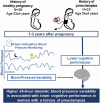Twenty-Four-Hour Blood Pressure Variability Is Associated With Lower Cognitive Performance in Young Women With a Recent History of Preeclampsia
- PMID: 34278420
- PMCID: PMC8643581
- DOI: 10.1093/ajh/hpab112
Twenty-Four-Hour Blood Pressure Variability Is Associated With Lower Cognitive Performance in Young Women With a Recent History of Preeclampsia
Abstract
Background: Women with a history of preeclampsia (hxPE) exhibit sustained arterial stiffness and elevated blood pressure postpartum. Aortic stiffness and 24-hour blood pressure variability (BPV) are associated with age-related cognitive decline. Although hxPE is related to altered cognitive function, the association between aortic stiffness and BPV with cognitive performance in young women with hxPE has not been investigated. The objectives of this study were to (i) test whether cognitive performance is lower in young women with hxPE and (ii) determine whether aortic stiffness and BPV are associated with cognitive performance independent of 24-hour average blood pressure.
Methods: Women with hxPE (N = 23) and healthy pregnancy controls (N = 38) were enrolled 1-3 years postpartum. Cognitive performance was assessed in domains of memory, processing speed, and executive function. Twenty-four-hour ambulatory blood pressure monitoring and carotid-femoral pulse wave velocity (cfPWV) were used to measure BPV and aortic stiffness, respectively.
Results: Women with hxPE had slower processing speed (-0.56 ± 0.17 vs. 0.34 ± 0.11 Z-score, P < 0.001) and lower executive function (-0.43 ± 0.14 vs. 0.31 ± 0.10 Z-score, P = 0.004) compared with controls independent of education, whereas memory did not differ. BPV and cfPWV (adjusted for blood pressure) did not differ between women with hxPE and controls. Greater diastolic BPV was associated with lower executive function independent of 24-hour average blood pressure and education in women with hxPE (r = -0.48, P = 0.03) but not controls (r = 0.15, P = 0.38).
Conclusions: Select cognitive functions are reduced postpartum in young women with a recent hxPE and linked with elevated 24-hour diastolic BPV.
Keywords: ambulatory blood pressure monitoring; blood pressure; hypertension; postpartum; pregnancy/preeclampsia; pulse wave velocity.
© American Journal of Hypertension, Ltd 2021. All rights reserved. For Permissions, please email: journals.permissions@oup.com.
Figures




Comment in
-
Preeclampsia and Altered Cognitive Performance: A Glimpse Into the Future?Am J Hypertens. 2021 Dec 1;34(12):1261-1263. doi: 10.1093/ajh/hpab136. Am J Hypertens. 2021. PMID: 34447988 No abstract available.
References
-
- Leon LJ, McCarthy FP, Direk K, Gonzalez-Izquierdo A, Prieto-Merino D, Casas JP, Chappell L. Preeclampsia and cardiovascular disease in a large UK pregnancy cohort of linked electronic health records: a CALIBER study. Circulation 2019; 140:1050–1060. - PubMed
-
- Ton TGN, Bennett MV, Incerti D, Peneva D, Druzin M, Stevens W, Butwick AJ, Lee HC. Maternal and infant adverse outcomes associated with mild and severe preeclampsia during the first year after delivery in the United States. Am J Perinatol 2020; 37:398–408. - PubMed
-
- Benschop L, Duvekot JJ, Versmissen J, van Broekhoven V, Steegers EAP, Roeters van Lennep JE. Blood pressure profile 1 year after severe preeclampsia. Hypertension 2018; 71:491–498. - PubMed
-
- Usselman CW, Adler TE, Coovadia Y, Leone C, Paidas MJ, Stachenfeld NS. A recent history of preeclampsia is associated with elevated central pulse wave velocity and muscle sympathetic outflow. Am J Physiol Heart Circ Physiol 2020; 318:H581–H589. - PubMed

